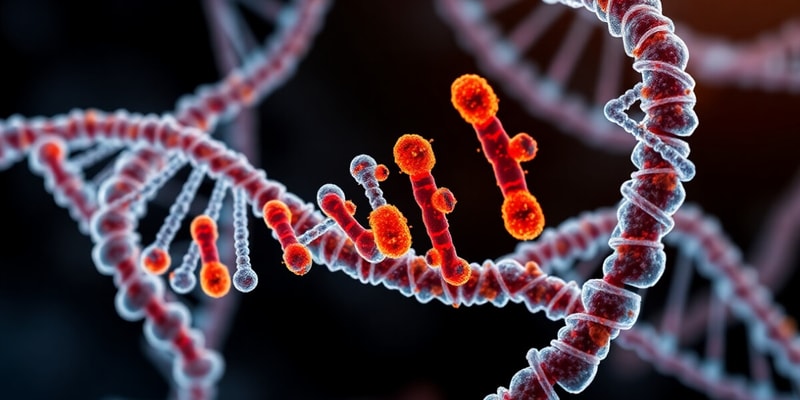Podcast
Questions and Answers
What does TALEN stand for?
What does TALEN stand for?
TALENs have a high potential for off-target effects compared to other genome editing techniques.
TALENs have a high potential for off-target effects compared to other genome editing techniques.
True
What is the primary function of TALENs in genomic engineering?
What is the primary function of TALENs in genomic engineering?
To make targeted double-strand breaks in DNA.
The RVD code in TALENs determines the _____ of nucleotide binding to the DNA.
The RVD code in TALENs determines the _____ of nucleotide binding to the DNA.
Signup and view all the answers
Match the following terms related to TALEN and their descriptions:
Match the following terms related to TALEN and their descriptions:
Signup and view all the answers
What does TALEN stand for?
What does TALEN stand for?
Signup and view all the answers
TALENs can cause off-target effects similar to other genome editing techniques.
TALENs can cause off-target effects similar to other genome editing techniques.
Signup and view all the answers
What is the primary function of a TALEN?
What is the primary function of a TALEN?
Signup and view all the answers
The precision in genomic engineering can be affected by off-target _____ in TALENs.
The precision in genomic engineering can be affected by off-target _____ in TALENs.
Signup and view all the answers
Match the following structural components of TALENs with their functions:
Match the following structural components of TALENs with their functions:
Signup and view all the answers
Which of the following describes the RVD code in TALENs?
Which of the following describes the RVD code in TALENs?
Signup and view all the answers
Double-strand breaks created by TALENs are always repaired by homologous recombination.
Double-strand breaks created by TALENs are always repaired by homologous recombination.
Signup and view all the answers
What are off-target effects?
What are off-target effects?
Signup and view all the answers
Which RVDs are specifically associated with the nucleotide bases G, A, C, and T?
Which RVDs are specifically associated with the nucleotide bases G, A, C, and T?
Signup and view all the answers
Genome editing results are always reversible.
Genome editing results are always reversible.
Signup and view all the answers
What is the main purpose of TALEN?
What is the main purpose of TALEN?
Signup and view all the answers
TALEN is created by adding FokI or part of its ______.
TALEN is created by adding FokI or part of its ______.
Signup and view all the answers
Match the following terms with their descriptions:
Match the following terms with their descriptions:
Signup and view all the answers
What can facilitate binding and cutting during genomic engineering?
What can facilitate binding and cutting during genomic engineering?
Signup and view all the answers
Off-target effects can potentially lead to deleterious effects in genomic engineering.
Off-target effects can potentially lead to deleterious effects in genomic engineering.
Signup and view all the answers
What is a critical factor when aiming for precise targeting of gene loci?
What is a critical factor when aiming for precise targeting of gene loci?
Signup and view all the answers
The process of ______ is used to permanently alter genetic material.
The process of ______ is used to permanently alter genetic material.
Signup and view all the answers
Which of the following statements is correct regarding TALEN structure?
Which of the following statements is correct regarding TALEN structure?
Signup and view all the answers
Study Notes
Genome Editing I
- Key topics include DNA damage, ZFN, TALEN, and CRISPR/Cas9.
- Cas9 protein binds to CRISPR RNA and a target viral DNA.
- Learning objectives cover types of DNA damage, DNA repair mechanisms (NER, BER, HR, NHEJ), genome editing methods (TALEN, Zn finger nuclease), and advantages/disadvantages of each.
Types of DNA Damage
- Transitions are changes of nucleotide within the same base type (pyrimidine or purine).
- Transversions involve changes from pyrimidine to purine or vice versa.
- Insertions or deletions of one or two base pairs alter the gene reading frame.
- Simple changes can affect only one base or lead to deleterious changes to proteins.
- UV light can damage thymine bases, leading to thymine dimers.
- UV light can also damage cytosine bases, leading to cytosine hydrate formation.
- DNA strand breaks include single-strand breaks (SSB) and double-strand breaks (DSB).
DNA Repair Mechanisms
- Multiple DNA repair mechanisms occur, including:
- Thymine dimer cleavage
- Base excision repair (BER)
- Nucleotide excision repair (NER)
- Homologous recombination (HR)
- Non-homologous end joining (NHEJ)
Genome Editing Tools
- Zinc-finger nucleases (ZFNs) facilitate the formation of a double-strand break (DSB) at a specific locus.
- ZFNs can be constituted of several zinc finger proteins (ZFPs).
- FokI is the non-specific restriction enzyme that induces the DSB.
- TALENs are transcription activator-like effector nucleases.
- TALEs consist of DNA-binding repeats, nuclear localization sequence, and transcriptional activation domain.
- Two highly variable residues (RVDs) allow recognition of single base pairs.
- CRISPR/Cas9 is a gene editing tool.
- CRISPR/Cas9-based systems use gRNA to target specific DNA sequences.
- Exogenous DNA addition is possible through homology-directed repair (HDR) using vector-borne DNA. Homology arms need to be engineered into replacement DNA.
Off-Target Activity
- Precise targeting of gene loci is important.
- Genomic engineering at unintended sites can have deleterious effects.
- Off-target effects can result from insufficient specificity of DNA binding or ambiguity of interdomain linker.
- Off-target effects can include insertions and deletions.
Studying That Suits You
Use AI to generate personalized quizzes and flashcards to suit your learning preferences.
Related Documents
Description
Explore the fundamental concepts of genome editing, focusing on various DNA damage types and repair mechanisms. This quiz covers key methods like ZFN, TALEN, and CRISPR/Cas9, along with their advantages and disadvantages. Understand the intricacies of DNA transitions, transversions, and the effects of UV light on DNA.




